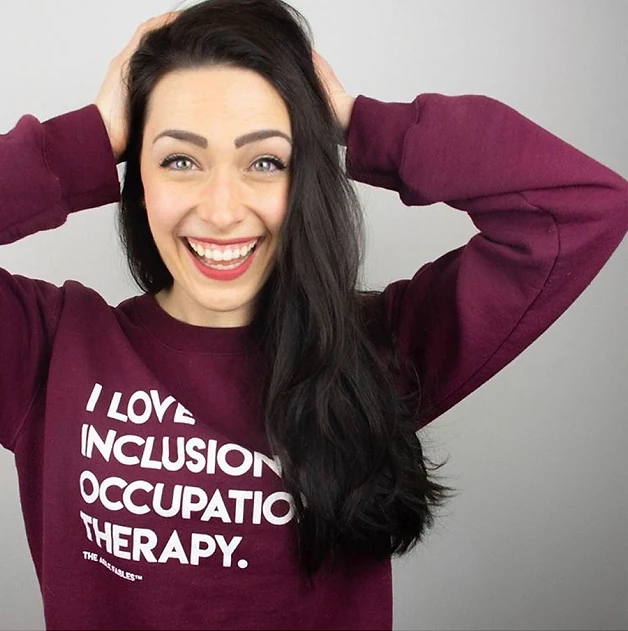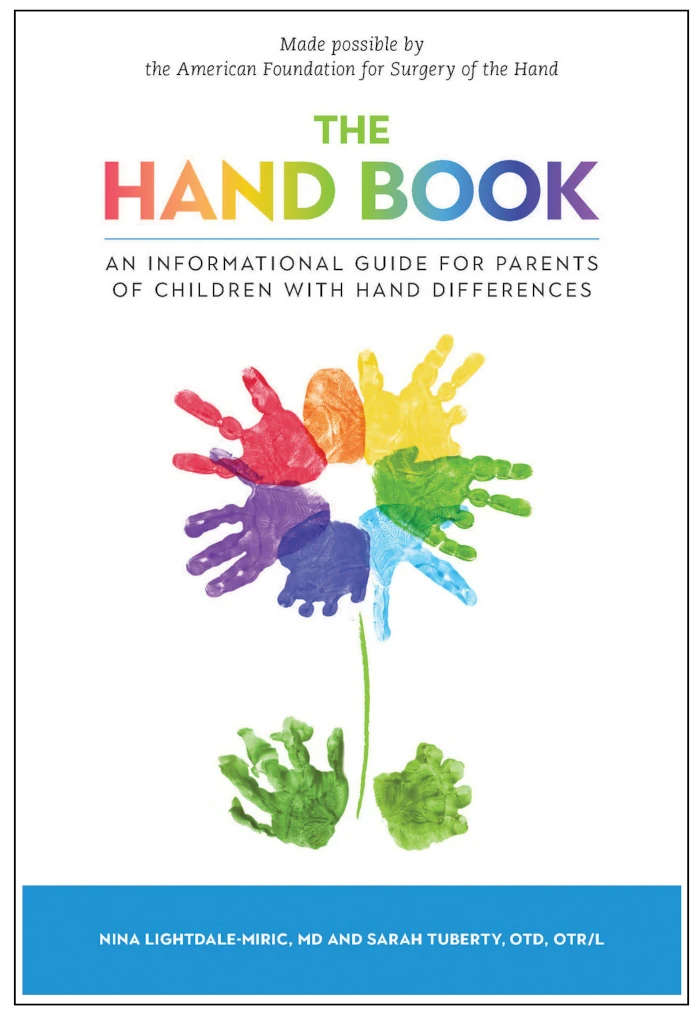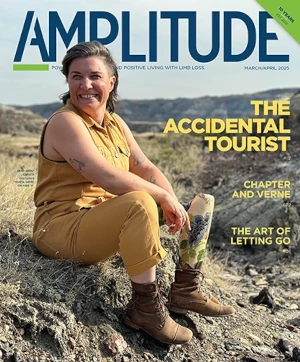When Sarah Tuberty was growing up with a congenital limb difference in the 1990s, there weren’t many signposts her parents could follow to prepare her for life in an able-bodied world. Social media didn’t exist, and the internet was a sparsely populated frontier. There were no online communities to turn to for answers, nor any robust analog organizations (such as the Lucky Fin Project) to connect them with other families raising kids with similar disabilities. The Amputee Coalition itself was still in its infancy, just beginning to assemble the resource library known today as the National Limb Loss Resource Center.
Today’s families can tap all those sources of support, and then some. Even so, they often struggle to find the tools they need to raise healthy, well-adjusted kids with congenital limb difference. Which is why Tuberty teamed up with pediatric hand surgeon Nina Lightdale-Miric to write The Hand Book: An Informational Guide for Parents of Children With Hand Differences.
“It’s got all the things my parents wish they had known when they were raising me,” says Tuberty, an occupational therapist based in Pennsylvania. “Or things I wish I had known myself. Like, when parents today ask me, ‘How did you deal with bullying at school?’ in my head, I’m thinking, ‘Well, I just cried in the bathroom.’ But that’s not helpful.”
“The Hand Book” is helpful. Published last month by the American Society for Surgery of the Hand (ASSH), the volume takes an interactive approach that helps families find their way to solutions that fit their own journeys. “Every child is their own unique, beautiful person,” says Tuberty. “There’s no right or wrong answer that’s going to apply in every case. We wanted to present different options, and explain the possible benefits and disadvantages that go along with each option. And then every family can decide what works best for them.”
You can order a copy of the book directly from the ASSH, and all proceeds go to the American Foundation for Surgery of the Hand to support future projects like this one. Tuberty spoke with us a couple weeks ago to describe the genesis of this project. Our conversation has been edited for length.
What inspired you to write this book?
There wasn’t a singular moment where it came into being. There’s been a whole history, a variety of events. In the book I share some of my experiences volunteering at Camp Winning Hands. It’s a summer camp that is put on by the UCSF Benioff Children’s Hospital and Shriners in Northern California. It started in 2009 to provide children with limb difference a chance to just have fun, meet each other, learn from each other, and realize they’re not alone. They get opportunities to try rock climbing, learn how to kayak, things like that.
I was 19 the first year they held it, and I met all of these parents who were hurting. They had so many questions, and everything was still new for a lot of them. They had a really tough time imagining what a future for their child could look like. They would ask me things like, “Should we do this surgery?” “Should we try this treatment?” And I would have to answer, “I can’t say whether you can have a surgery or not. But here’s my journey.” That’s truly where I first started reflecting about my own journey and my parents’ journey, and thinking about trying to support families.
Ever since, I’ve gone to Camp Winning Hands every year. That’s also where my interest in occupational therapy came from. One year there was a young woman who had just started high school, and she wanted to put her hair up. But she was having a tough time with her limb anatomy, figuring out how to get her hands to hold the band at the top of her head. So we were exploring that, and I was helping her, and I thought: “This is amazing. How can I just live here for the rest of my life?” And that’s when the light bulbs for OT went on.
Fast forward to my OT graduate program, which I started in 2016. My research project for OT school was to develop a parent resource. I worked with a hand surgeon, and we created a website that covered lots of common things that parents had asked me. I read tons of academic research, and I tried to put it across in a way that could be helpful for parents.
Is that what formed the basis for this book?
In a way. I gave a presentation about that website at a conference, and Nina Lightdale-Miric, who is a pediatric hand surgeon at the Children’s Hospital of Los Angeles, approached me and and said, “I’ve been thinking about how there needs to be a resource like this. Will you write a book with me?” So starting in 2019, we began expanding on everything that was in the website to create this book.

It sounds as if Dr. Lightdale-Miric had already been thinking along the same lines as you.
She and her husband started something equivalent to Camp Winning Hands down in Los Angeles. It’s called CATCH [Center for Achievement of Teens and Children With Hand Differences], and it’s a one-day picnic event that allows parents and families and kids to come together and get to know each other. They put that on annually to try to foster and build that community. From putting on CATCH, she started seeing parents who have all these different questions, and started to feel there’s a real need for a research resource.
Dr. Lightdale-Miric also had a patient, a teenager with an upper-limb difference, and—perhaps he had some other things happening in his life, but he ultimately committed suicide. And that really affected her. This was somebody who was in her care. This young person was struggling with what their body looked like. Perhaps there were other things also happening in his life. But she started to think about creating a resource that’s not just about someone’s medical needs, but also their psychosocial concerns. Because it’s not just their hand. It’s their whole life. That is a very real thing.
Was it hard to get that across when you began writing?
Oh my gosh. We’re not authors, right? We’re healthcare professionals. We’re not trained in how to structure a book and how to write really beautiful essays. We just knew we wanted to empower parents to make their own choices. We wanted to create a resource that parents could pick up, put down, take what they wanted from it, and reject what they didn’t want. There isn’t anything in the book that says that you should or shouldn’t do this or that. It was more about sharing everything that we know, giving people the words that could help them do their own research, and providing a framework and some structure for people to gain understanding.
Initially, we had one chapter about the emotional elements of having a child with limb difference. There’s documented research that parents who have a child that has some type of difference or disability go through the same bereavement process as parent who have lost a child. They go through all the same stages of grief and coping, because the parents are essentially losing their idea of this perfect child. We had all of that in one chapter, but one of our editors changed the structure and made it infinitely better. Now that emotional element is interwoven into all the chapters, instead of being nestled in its own section.
When I reviewed the sample chapter online, it ended with a worksheet. Are those sprinkled throughout the whole book?
Yes. I love worksheets. I personally find they’re a good way for me to process and understand. And I am an occupational therapist, so worksheets are plentiful in my work. So that felt natural.
There’s a financial worksheet that includes the impact of insurance and reimbursements. There’s one on different things to consider when choosing hospitals or choosing treatment options. We have something we call the menu of interventions, so people have appropriate knowledge and appropriate expectations of various kinds of treatment. You can find yourself in some opinionated conversations about some of these interventions. We want people to know that there are no absolutes. You can always choose to do something, or not to do it, based on what you and your child are comfortable with. The worksheets are kind of a way to process all of the information in the book and decide how it applies to your child.
Another element we’re really excited about is that we have a feedback link. Anybody who reads the book can use the feedback link to provide their thoughts. So we’re both really excited to then hear mass feedback. We would love to collect that feedback and find out what was great, what wasn’t great, what things parents want more of, and what things were too complicated. That will help us just create better future editions.
Here’s where you can order your own copy of The Hand Book: An Informational Guide for Parents of Children With Hand Differences.





